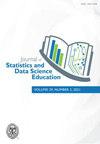统计和数据科学课程无障碍和包容性教材框架
IF 1.6
Q2 EDUCATION, SCIENTIFIC DISCIPLINES
Journal of Statistics and Data Science Education
Pub Date : 2021-10-12
DOI:10.1080/26939169.2023.2165988
引用次数: 3
摘要
尽管数据科学劳动力快速增长,但有色人种、女性、残疾人和其他人群在该领域的代表性不足、服务不足,有时甚至被排除在外。这种模式阻碍了个人机会的平等,同时也创造了使不平等永久化的产品和政策。因此,作为下一代统计和数据科学教育者,我们必须将可及性和包容性贯穿于课程、课堂环境、评估模式、课程材料等各个方面,这一点至关重要。尽管一些常见的策略适用于这些领域,但本文的重点是提供一个框架,用于开发可访问和包容性的课程材料(例如,课堂活动,课程手册,讲座幻灯片等),并从我们共同编写统计学教科书的经验中提取示例。反过来,这个框架建立了一个让我们对这些原则负责的结构。本文章由计算机程序翻译,如有差异,请以英文原文为准。
Framework for Accessible and Inclusive Teaching Materials for Statistics and Data Science Courses
Abstract Despite rapid growth in the data science workforce, people of color, women, those with disabilities, and others remain underrepresented in, underserved by, and sometimes excluded from the field. This pattern prevents equal opportunities for individuals, while also creating products and policies that perpetuate inequality. Thus, it is critical that, as statistics and data science educators of the next generation, we center accessibility and inclusion throughout our curriculum, classroom environment, modes of assessment, course materials, and more. Though some common strategies apply across these areas, this article focuses on providing a framework for developing accessible and inclusive course materials (e.g., in-class activities, course manuals, lecture slides, etc.), with examples drawn from our experience co-writing a statistics textbook. In turn, this framework establishes a structure for holding ourselves accountable to these principles.
求助全文
通过发布文献求助,成功后即可免费获取论文全文。
去求助
来源期刊

Journal of Statistics and Data Science Education
EDUCATION, SCIENTIFIC DISCIPLINES-
CiteScore
3.90
自引率
35.30%
发文量
52
审稿时长
12 weeks
 求助内容:
求助内容: 应助结果提醒方式:
应助结果提醒方式:


